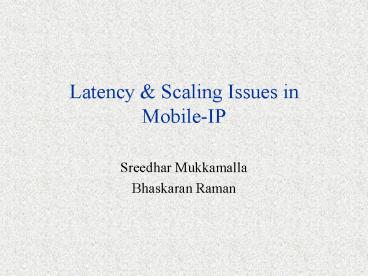Latency - PowerPoint PPT Presentation
Title:
Latency
Description:
In search of the right mobility architecture... Project Goals ... Large number of cell-phone users. How many mobile hosts can an agent handle ? Basic Mobile IP ... – PowerPoint PPT presentation
Number of Views:78
Avg rating:3.0/5.0
Title: Latency
1
Latency Scaling Issues in Mobile-IP
- Sreedhar Mukkamalla
- Bhaskaran Raman
2
Motivation
- ICEBERG project
- packet switched cellular telephony network
- flexible service architecture
- Universal INBOX
- Location based services etc.
- In search of the right mobility architecture
3
Project Goals
- Mobile IP IETF Standard for mobility
- Is it suitable for ICEBERG ?
- Wide area registration latency
- Is it a problem ?
- Large number of cell-phone users
- How many mobile hosts can an agent handle ?
4
Basic Mobile IP
- Triangle routing problem
- Wide-area registration latency
- Registration mechanism
- MH registers with HA through FA
- If registration times out, retry with exponential
back-off - Minimum RTO 1 second
HA
IP tunnel
CH
FA
Mobile Host
5
Wide area registration latency vs Time
- Ping measurements to Rutgers - used in simulation
- No congestion 70 ms latency During congestion
1600 ms latency - Congestion during day time 7am-5pm PST RTT
540 ms - With no back-off during losses, 1200 ms average
latency
6
But...
- Machine at CMU
- average latency around 190 ms
- latency gt 200 ms only 3 of the time
- Machines at MIT UNC
- average lt 100 ms
- latency gt 200 ms less than 0.2 of the time
- Machine at UMD
- average 1200 ms
- latency gt 1 sec for more than 1/6th of the time
7
Scaling Measurements
- Experimental Setup
- FreeBSD implementation of Mobile-IP
- Pentium (300MHz) machines on 100 Mbps Ethernet
- Mobility emulated by modifying code at MH
- Measurements to determine
- Hand-off rate that an agent can handle
- Data traffic that an agent can handle
8
Results
- FA can handle about 2500 registrations per second
- User-level handling of registration messages
- HA/FA can handle data traffic (tunneling/de-tunnel
ing) at 20,000 packets per second - 160 byte packets
- Equivalent to about 1000 two-way audio streams
- Ethernet gets saturated
- Conclusion An agent can handle at least a few
hundred mobile hosts
9
Conclusions
- Processing is not the bottleneck
- at least for up to a few 100 users per agent
- Wide-area registration latency
- Very less for some sites, unacceptably high for
others - Should we optimize the architecture at the IP
layer for performance ? - End-to-End argument gt IP mobility support
required - But, optimizations should probably be made at the
link layer































